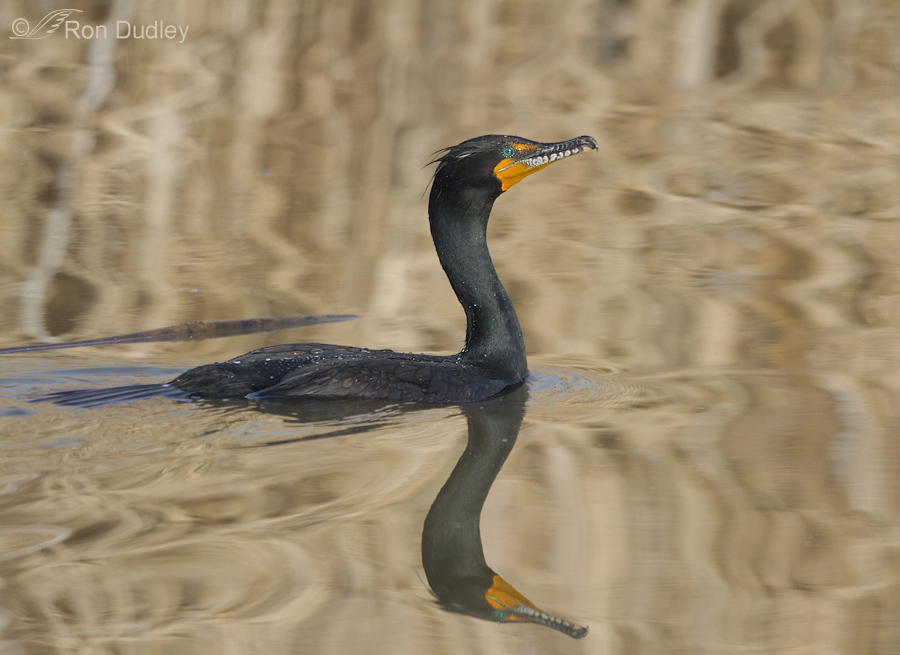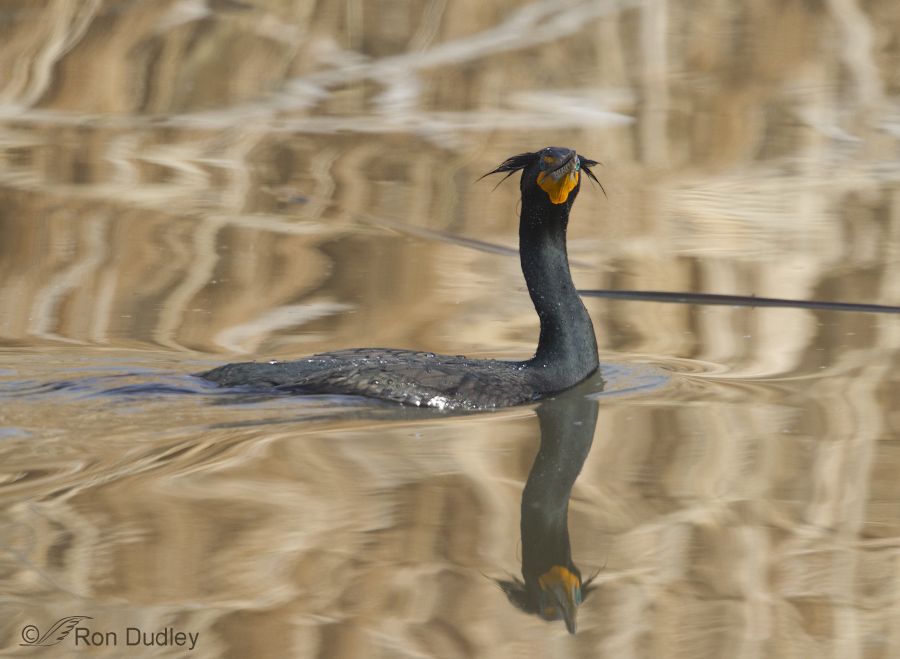The Double-crested Cormorant is a common species throughout most of the continental U.S. but its namesake “double crest” is seldom seen well.
The crests, also called nuptial crests, are supposedly “ear-like” (thus the species name auritus) but they are a poor field mark because they’re present for only a short time. They are produced in late winter by a partial molt on the head and are lost by June before the breeding season is over. The waxing and waning of the crests is the only seasonal change in this species.
1/1600 f/5.6, ISO 640, Canon 7D, 500 f/4 II, 1.4 tc, not baited, set up or called in
I photographed this cormorant three days ago at Bear River Migratory Bird Refuge. I enjoy the characteristic turquoise eyes and the golden reflections on the water, though the floating stick behind the bird may not be ideal for some.
At this time of year the crests are fully developed but still often difficult to see because they are usually (though not always) the same color as the head and neck feathers and because they are typically wet and slicked back against the rest of the plumage. Here the crests can be seen, but not well.
A less flattering head angle gives us a better look at the crests. Interestingly, the crests of western cormorants are about twice as long a those of eastern birds (78mm vs 38mm).
These birds have been harassed, persecuted and killed for centuries because of their fish-eating habits and their perception as competition by commercial and recreational fishermen and by fish farmers (catfish in particular). This resulted in a widespread decline in the species during the 19th century but thankfully have made a comeback since they were added to the Migratory Bird Convention in 1972. This antagonism toward cormorants is largely misdirected because in natural environments fish species of interest to fishermen rarely make up a significant portion of the diet of these birds.
At one of my “bird haunts” cormorants often fly low overhead as they carry nesting material toward their nest site much further away. One of my goals for this season is to get some decent flight shots of them as they do so.
Ron




After meeting a Cape Cormorant in Namibia just over a month ago, I was interested to see that this species also has the turquoise eyes. Those eyes are so beautiful. Unfortunately with the lighting we had that day (and my point & shoot camera) it was very difficult to capture the eye color in my photos. I hope you can get the shots you want of these birds, and I’ll look forward to see in them. These photos are a great introduction to the species.
What a beautiful creature, thanks for sharing the photos! 🙂
I think cormorants have the prettiest eyes I’ve ever seen. I love the greenish-blue color!
Perhaps the difference in crest length is why I never really noticed the crests here in Ohio.
Regarding their persecution, the Cormorants have made a tremendous recovery in the Midwest, to the point that they are crowding out other species such as Blue Heron and Egrets. Though smaller than an egret in stature, they outweigh them by a pound or two. They also nest earlier than the herons and egrets, and so grab and hold many of the best spots. I have heard that in some areas around Lake Michigan wildlife agencies are culling cormorants to protect other species.
Since stumbling upon your blog I have been an admirer of your work for a couple of years now. Your work sets the bar in my eyes. When I’m looking through them it makes me want to grab my camera and head out. I aspire to be as good. Thanks for sharing your captures. I’m fortunate enough to be able to walk out my door and be surrounded by Snowy’s this time of year. I can appreciate just how difficult it is to capture images like these.
Thanks very much, Jamie. I’m so jealous of your Snowy Owls. I’ve never seen one in the wild and likely never will. DO! – grab your camera and “head out”, every chance you get. You’d be surprised what you can get when you put in the effort and the time.
It’s one bird you should try to make time for if at all possible. If you ever head to Southern Ontario in January I’d be glad to introduce you. We get about a dozen in my area. Mostly females. It’s almost a celebration around here amongst the photographers.
Where do you live, Jamie…you lucky, lucky thing? The only “Snowys” I get to see are snowy trees, bushes, lawns, streets, fields, cars, houses, driveways…..and I’M SICK! SICK! SICK! … OF those “Snowys”….just heard we may have more on Wed. (this March for Pete’s sake!!!)
I’m in southern Ontario just north of Toronto.
Will be near that area soon…IF I’m really lucky, maybe I’ll see some…There have been quite a few in our area this winter, I but would have to head for the city (NY) to see them and I’d rather drive across the country or to Alaska than head in that direction…
Thank you so much Ron. We do see these birds at Elizabeth Lake, however, I have never been able to get close enough to see the color of their eyes. Their eyes are beautiful. Great shots as usual!
I’m glad you enjoyed seeing the eye color, Jean. It’s quite unique in my experience.
Those birds may be “common” to some, but not to all of us . In first image, bird looks fairly elegant, seems to be going 100 mph…in second, he looks a little insane and a bit like a brunette Donald Trump in a strong wind….
I have to agree with you Patty. They often look stuck up to me.
Patty, You’re a card! Feeling a little down in the dumps (nothing major) and your Donald Trump reference made me chuckle. I needed that – thanks.
So glad to return the favor…you make me smile every morning!
Love the ‘double crest’ photo. And those eyes…
Great shots! Love DC cormies!!
Thank you, Nala.
Wonderful article on the seldom-observed namesake of this bird! This is another of those birds so easy to overlook because it’s so common, but which is so interesting to observe when we take the time to do so. Just like most birds!
Terrific images, Ron! (Well, except for that annoying stick……)
Exactly, Wally. Common certainly doesn’t mean uninteresting!
Striking colors … aqua eyes and golden face … and of course, gotta love the ‘do!!!!!
Lois, it’s those eyes that I find most striking.
I don’t think I have ever seen even a picture of this before. Such stunning eyes! Beautiful!
Thanks, Leisa.
Thanks for sharing photo and info … I’ve never seen a bird like that. Very interesting and nice shots.
You’re very welcome, Patricia. Thank you.
Interesting info and wonderful shots Ron!
Charlotte
Thanks, Charlotte.
The second shot, whit the crests out to the sides, made me chuckle.
Me too, Pam. Silly looking bird…
Great shots Ron.
As you probably know the tufts on a Double-crested Cormorant are black less conspicuous in eastern birds and mostly white on western birds. Your bird has a tint or a hint of white in the tuft of the first picture, makes me wonder whether there is breeding between the western and eastern sections. It would seem to me that that would occur, but I personally don’t know how true that characteristic is, but very interesting at any rate.
Dick, Yes, the crests are supposed to be black in the east and mostly white in the west. However most of the birds I see here in Utah have black crests or a few have black with a feather or two that is white. I’ve never seen one with a “mostly white” crest and I thought Utah was a “western” state. Go figure…